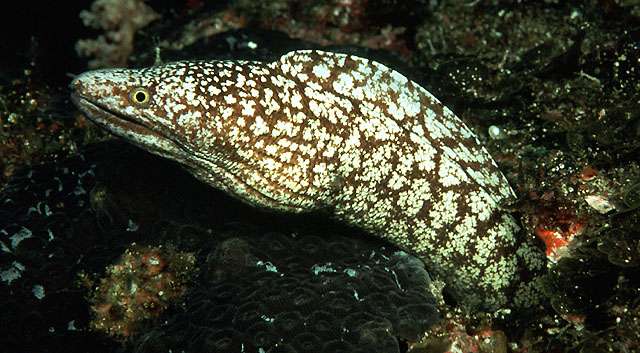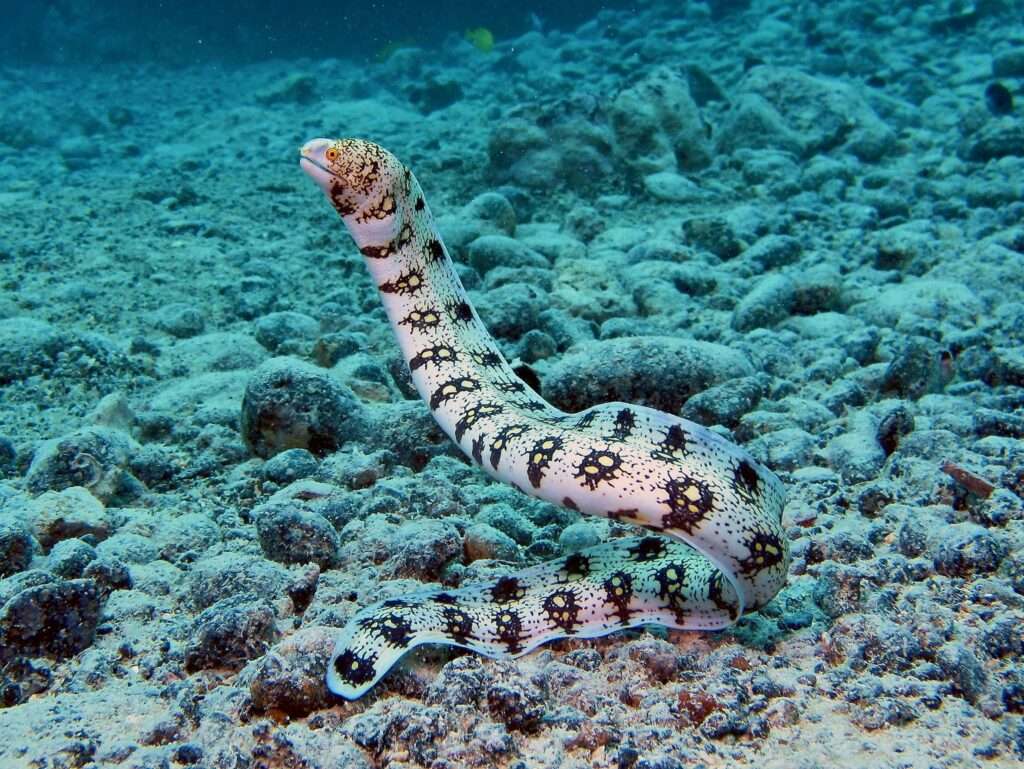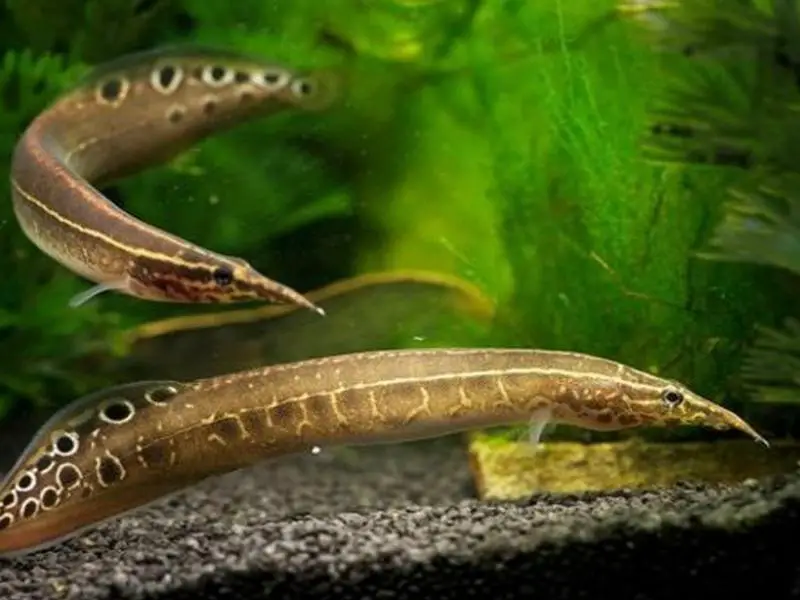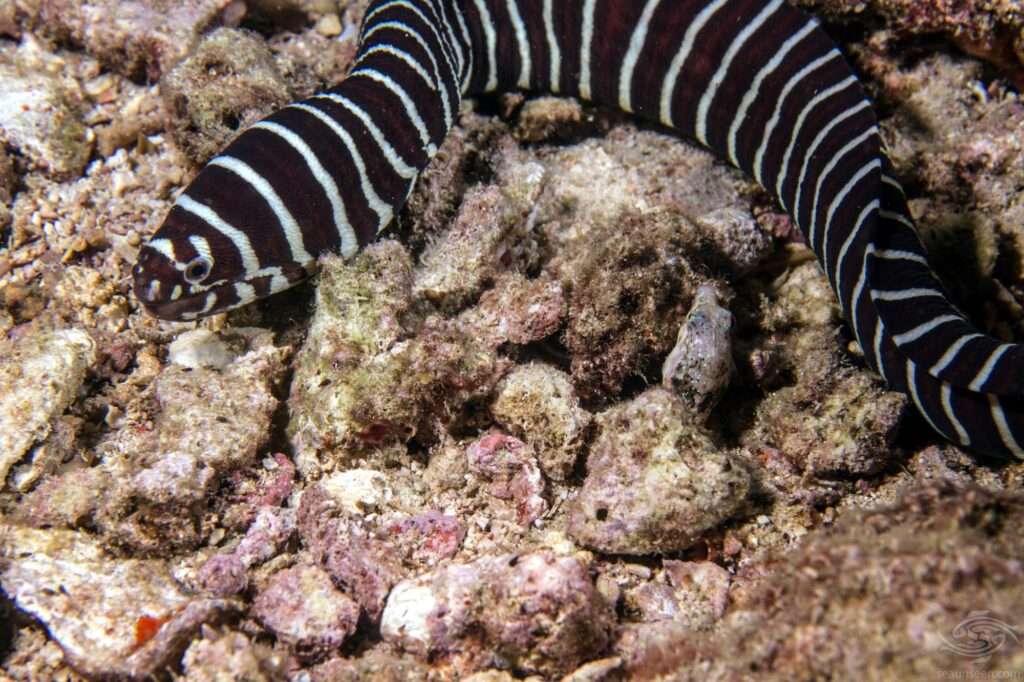
The Kidako Moray Eel is a large snowflake-shaped fish that is dark brown with various colors of yellow, gold, and tan. Because of this, juveniles resemble the tiny snowflake eels. When swimming in low light conditions in nature, certain fish seem virtually black. They lack boney gill plates over their lengthy gill area and have continuous dorsal and anal fins. The teeth in the center of their upper jaw can actually fold back against the roof of their mouth, and they have exceptionally sharp teeth. The Kidako Moray Eel can grow to a length of 39.4″ (1+ m), has a lifespan of 10 to 30, and is best kept by experienced aquarists.
All morays have the potential to appear extremely cruel simply by breathing. It’s now their responsibility because that’s the only way they can get water to pass through their gills and down their throats! In some parts of Japan, these guys are eaten! This food has the potential to bite back! Because of their razor-sharp teeth, Kidako Moray Eels will break up larger pieces of prey that they can’t swallow by spinning their body, pulling, knotting, and thrashing, while smaller prey is consumed whole. Fish will be manipulated such that they are swallowed head first.
Other fish frequently pursue morays while they hunt. These fish are taking advantage of the Kidako Moray Eel’s easy food that it has flushed off the reef. A side note: Eels lose their outer slime coat to defend themselves, so if you find an eel that has dried up on the floor, put it back in the tank right away.
Kidako Moray Eels are simple to maintain. Foods like fresh squid flesh, marine fish flesh, and crab flesh should all be available. Avoid overfeeding them to avoid them getting a fatty liver or throwing up dinner. Not a mess I’d want to clean up! Even if they ask to be fed more frequently, feed them until they are full every 3 to 4 days. Children may require feeding every other day at first, then less frequently as they get older. If they aren’t eating, it’s usually because the water is bad, the pH is too low, they’ve been fed too much, or for no apparent reason at all. Altering your diet or changing some of your water could be helpful. They might not start eating again for a few weeks.
Habitat
Temminck & Schlegel published the first description of the Kidako Moray Eel, Gymnothorax kidako, in 1846. Gymnothorax is the name of a genus, which sounds like a bodybuilder trying to obtain a six-pack! Let’s try to deconstruct the word. Greek terms “gymno” and “thorax” both denote nakedness.
The Kidako Moray Eel can be found in the Western Central Pacific, off the coasts of Japan, Taiwan, Hawaii, the Society Islands, and the Ogasawara Islands. They reside in shallow reefs’ deep crevices at depths ranging from 10 to 195 feet (3 to 6 m). They consume ordinary finned fish, cuttlefish, and squid. They are incredibly courageous and will take fish that divers are reeling in! In some regions of Japan, people consume them.
Description
A long, deep-bodied fish without pectoral or pelvic fins, the Kidako Moray Eel. They lack the bony plate covers found on other fish’s large, extended gill apertures, which have tiny holes instead. They lack scales and have a continuous dorsal and anal fin. Their mouths are equipped with formidable teeth, including retractable ones on the roof of the mouth that are ideal for capturing prey or inflicting severe injuries. Depending on the specimen, the body is colored brown with what appears to be snowflake patterns throughout in yellow, pale yellow, or gold to tan. They grow to a height of 39.4″ (1+ m) in the wild and are found alone. If they don’t escape, moray eels can live for 10 to 30 years.
Keeping as Pet

Food
Carnivores are Kidako Moray Eels. Do not give them freshwater fish, such as goldfish, to eat. These foods are not very nutritious and will eventually make you sick. Feed them fresh squid, scallops, shrimp, marine fish flesh, and other marine flesh. Feed them every three to four days until they are satisfied. If you feed them more frequently than that, they may grow a fatty liver or throw up an additional meal, which will create a major mess in the tank. Juveniles need to be fed more frequently, every other day, and less frequently as they get older.
Aquarium for Common Moray Eel
The Kidako Moray Eel requires little maintenance; the main issues are tank size, tank mates, and the length of commitment. Any fish you may have in the aquarium are in danger because of them. Feed your eels using a feeding stick in front of their hiding place to reduce, though not necessarily eliminate, predation. They might learn to wait for food instead of swimming around trying to eat your other fish. They require a location where they can totally conceal their bodies, such as a huge 3″ around or longer PVC structure that is 3 to 4″ long. Fiberglass should not be used as it affects their skin.
But seriously, the tank needs to hold 300 gallons or twice as much because they generate a lot of waste that degrades water quality. Once the water is steady and matured, large tanks larger than 100 gallons can have 15% to 20% of their water changed weekly, depending on the bioload.
Table





